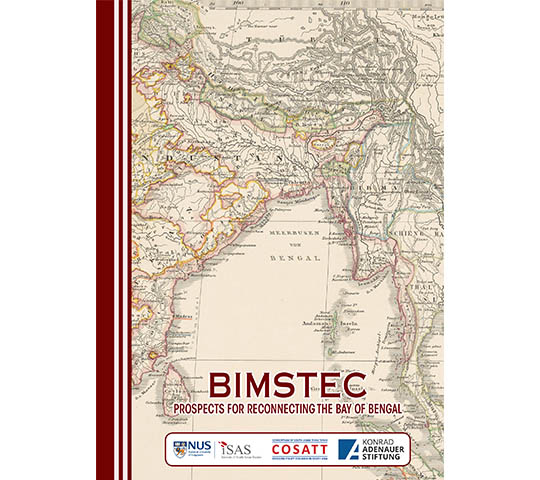63: BIMSTEC: Prospects for Reconnecting the Bay of Bengal
Amitendu Palit and Silvia Tieri
30 September 2019Regional integration and connectivity initiatives in Asia have received a boost from the noticeable spike in interest on the Bay of Bengal Initiative for Multi-Sectoral, Technical and Economic Cooperation (BIMSTEC). The BIMSTEC has moved at an exceptionally sluggish pace for more than a decade after its initial formation in 1997.
Over the last few years, however, the BIMSTEC has captured considerable attention. Much of the attention is on account of the government of Prime Minister Narendra Modi in India focusing prominently on the BIMSTEC as key parts of its ‘Neighbourhood First’ and ‘Act East’ policies, envisioned through India’s more meaningful engagement with not only neighbouring South and Southeast Asia, but also the rest of the Asia-Pacific. As the largest economy in the BIMSTEC, India’s role is vital in expanding its scope and realising its prospects.
The strategic importance devoted by India to the BIMSTEC is evident from the invitation to the Heads of States of the BIMSTEC member countries to attend the swearing-in ceremony of Prime Minister Modi as he assumed his second term in office on 30 May 2019. The invitation to the BIMSTEC also sparked speculation over whether, from an Indian strategic perspective, greater engagement with the BIMSTEC meant a commensurate disengagement with the South Asian Association for Regional Cooperation (SAARC). India’s disappointment with SAARC as a regional forum, as opposed to the brighter prospects it visualises from the BIMSTEC, has been evident from the Indian External Affairs Minister Dr S Jaishankar’s emphasis on the ‘energy’ in the BIMSTEC vis-à-vis the ‘problems’ in the SAARC.
Given the Indian attention, as well as that from the region, on the BIMSTEC, which is contributed in no small measure by the burst in regional connectivity across Asia, this Special Report studies the BIMSTEC and its key priorities. Discussing the BIMSTEC’s progress as an organisation and its work areas, the paper reflects on the importance of connectivity for the BIMSTEC as it works hard to step up intra-regional transport linkages through land, sea and cyberspace. This report underlines the importance of the BIMSTEC establishing its long-term credibility with local populations and communities for successful maturing, as well as the benefits it can obtain by locking onto ongoing regional connectivity projects, and the implementation of ‘best practices’ in the areas of trade facilitation. Its key challenge is to overcome its sluggish pace of progress, which again, can be addressed, if it adopts the successful cooperative practices that some members have already put in place, like India and Bangladesh within the Bangladesh-Bhutan-India-Nepal (BBIN) sub-regional grouping. Successful cooperative frameworks like the understanding reached on intra-regional grid connection enabling trade in electricity can enable members to achieve substantial long-term benefits and establish an inclusive model of regional cooperation. While India will continue to be prominent in the BIMSTEC by its sheer size, its commitment to the region as a development partner will reduce misgivings about its role.
This report has been drawn from the discussions and views presented at ‘BIMSTEC at 20: Priorities and Prospects’ – a workshop organised jointly by ISAS with the Consortium of South Asia Think-Tanks and the Konrad-Adenauer-Stiftung – in Singapore on 24 September 2018. Ambassador M Shahidul Islam, Secretary-General of the BIMSTEC, delivered the keynote address at the workshop, and Ambassador Ong Keng Yong, Executive Deputy Chairman of the S. Rajaratnam School of International Studies at the Nanyang Technological University, Singapore, delivered a special address. The workshop was attended by delegates from all BIMSTEC member countries.
-
 More From :
More From :
-
 Tags :
Tags :
-
 Download PDF
Download PDF


